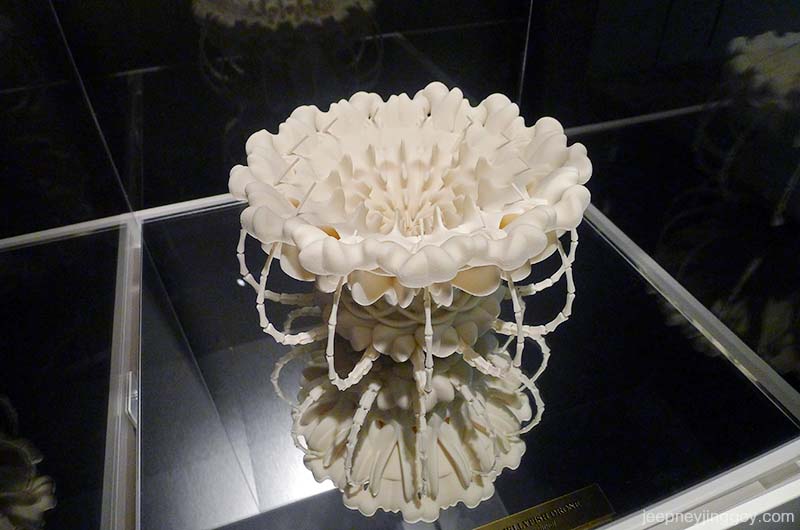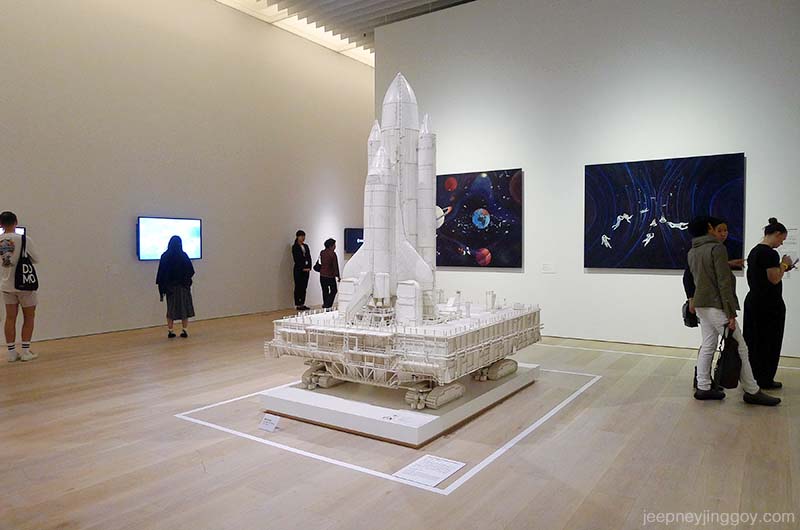The visit to Mori Art Museum was not on the list. In fact, except for the National Art Center, I never knew this museum existed in Roppongi Hills at all. The only reason I wanted to visit the area was to see the Maman, one of several giant spiders by Louise Bourgeois, the first one of which I caught sight at the Guggenheim Museum in Bilbao.
 |
| Maman, the giant spider, on the Mori Tower's concourse |
Did I find the museum by chance or was it fated? The Universe has its ways of turning our heads to the direction we should take.
I’m an avid admirer of contemporary art and the museum is a home for this art genre. This I only found out after taking photos at the spiral staircase of the art cone and wondered where the stylish, artsy folks came from as they made their way down the flight. Next thing I knew I was on the elevator heading up to the museum.
 |
| The Art Cone stairway leads to the Mori Art Museum |
Apparently, the arachnid permanently displayed on the concourse of the Mori Tower is part of the museum. Another interesting fact about the Mori Art Museum is it doesn’t exhibit a permanent collection (I guess the spider is not included because it’s outdoors). What it does is hold temporary exhibitions of works by contemporary artists, which primarily are Asians.
 |
| The entrance to the Mori art Museum on the 53rd floor of the Mori Tower |
Perhaps it was timely that on my visit, two subjects of what I believe in were the themes: “The Universe and Art”. The exhibit, which ended in January, related how humanity has always taken great interest in the universe. For centuries, we have studied it, worshipped it and spun tales about it.
From across the globe, the museum selected around 200 items—artifacts from different periods and in diverse genres— and divided it into four sections.
 |
| Tours starts from this point |
Section one presented historical views of the cosmos in “How have humans through the ages viewed the Universe.” Displayed were ancient mandalas from China, a Japanese legendary sword forged from meteorite iron, astronomical manuscripts of Leonardo da Vinci (a first for Japan), and Galileo Galillei’s, Copernicus’ first editions of astronomical and scientific texts, and contemporary art by Japanese artists.
 |
| Section 1 of the The Universe & Art exhibit |
 |
| Mandalas, celestial globes, star maps, manuscripts by Leonardo da Vinci and Galileo Galilei & more |
 |
| The legendary Japanese Meteorite Sword forged from meteorite iron. 1898. Okayoshi Kunimune. |
“The Universe as space-time” was presented in the second section. It exhibited installations by contemporary artists that present their diverse views of the universe. Black holes and multidimensional universes took artistic forms.
 |
| The Milky Way (and me) viewed from point of entry |
 |
| Bjorn Dahlem's Black Hole (M-Spheres) is a reinterpretation of the Milky Way, in which the black hole is in the center. |
 |
| Kinetic art. "Timepiece" by Conrad Shawcross. "The piece references a sublime form of astronomical times, as experienced in sundials and interactions with the Sun." |
 |
| At the center of "Brilliant Noise". 2006. Semi Conductor. |
 |
| "Hermit from the Planet Dust" and two "Untitled" works by Jia Aili. |
Section three posed a question many ask, “A new life—Do aliens exist”. On display were fossils and meteorites, an Edo-period UFO story, and sci-fi magazines and sculptures representing artificial intelligence.
 |
| Section 3: A New View of Life- Do Aliens Exist. |
 |
| A genetically engineered being of an adorable baby and a caterpillar. "The Rookie" by Patricia Piccinini |
 |
| UFO in the Edo Period? Artworks of Utsuro-bune (hollow ship), said to have drifted ashore the coast of Hitachi Province (now Ibaraki Prefecture) |
 |
| Vincent Fournier's Robotic Jellyfish Drone (Cynaea Machina) is an imaginary specie taking its inspiration from synthetic biology & cybernetics |
The fourth section presented “Space travel and the future of humanity” where guests can explore space from where he stands. Shown on the floor were the history of American and Russian space exploration, models for housing on Mars and the moon, spacesuits. “Light in Space” let guests peek at how traveling through space must feel (the illusion was dizzying for me though).
 |
| Section 4: Space Travel and the Future of Humanity |
 |
| Sorayama Hajime's "Sexy Robot" (I doubled the exposure) |
 |
| Photographs: all about space travel. |
 |
| "The Crawler" by Tom Sachs |
It was an exciting first visit. What can I say but “thank you, Universe!”
 |
| The end of the line- the souvenir shop. |
 |
| Spacemen's diet |
Knowing that nothing is permanently exhibited in this museum peaks my interest and look forward to next contemporary exhibition. I know I will revisit this place when I make it back to Tokyo.
Mori Art Museum is on the 53rd floor of the Mori Tower, Roppongi Hills (access through the Museum Cone, 3rd level). Open daily from 10AM-8PM, until 5PM on Tuesdays. Admission is 1,600yen for adults, lower rates for students and kids.
Email me at jinggoysalvador@yahoo.com. For more lifestyle & travel stories, visit www.ofapplesandlemons.com & www.jeepneyjinggoy.com
Also publushed in the SunStar Davao newspaper.

















CONVERSATION